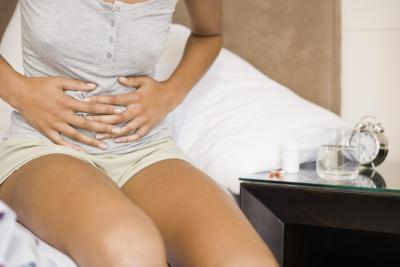Kidney stones form in the kidney from high levels of a particular substance in the urine. The types of kidney stones vary, based on the excess material in the kidney. The stones vary in size and may move from the kidney into the urinary tract. Larger kidney stones often become stuck with painful results. While men are more likely to have kidney stones, women also experience this condition.
Symptoms
Pain often indicates a kidney stone. The location of the pain varies and sometimes travels, but it primarily affects the abdominal area. You might experience pain in the lower back or in your side. If the kidney stones travel down the urinary tract, the pain also moves, sometimes reaching the genital area or groin. Nausea, vomiting, changes in urine color or appearance, blood in the urine, fever, chills and an increased feeling that you need to urinate are also possible symptoms.
Types
Calcium, struvite, uric acid and cystine are the four types of kidney stones. Women are more likely to have struvite kidney stones, which are often made of ammonia. This type of stone often appears after having several urinary tract infections. Calcium stones develop when excess calcium builds up in the kidneys. A high level of uric acid in the urine can lead to uric acid stones. Those who receive chemotherapy or who consume large amounts of protein are at a higher risk for this type of kidney stone. Cystine stones develop as part of a disease called cystinuria.
Diagnosis
Urine and blood tests help doctors diagnose kidney stones. The urine tests identify the crystals that create the stones and red blood cells. The tests also look for high uric acid or levels. Imaging technology allows the doctor to actually see the stones to confirm a diagnosis. X-rays, MRIs, CT scans and ultrasounds of the abdominal area show kidney stones. These tests can also show if the ureter is blocked by a stone.
Treatment
Small kidney stones often pass through the urinary tract on their own, but severe pain often accompanies the process. Pain relievers keep the discomfort under control. Increased fluid intake often helps flush the kidney stones out faster. Medications are sometimes prescribed to help break up the stones or prevent further stones from developing. For larger stones that cause other complications, surgery is an option. An analysis of an actual kidney stone determines the type of stone, which can help with treatment and prevention of future stones.
Prevention
Once you have kidney stones, you have an increased risk of developing them again. Certain precautions help prevent future kidney stones. Drink lots of water to produce plenty of urine throughout the day. Lowering your sodium, meat and protein consumption also helps reduce the risk of kidney stones.





